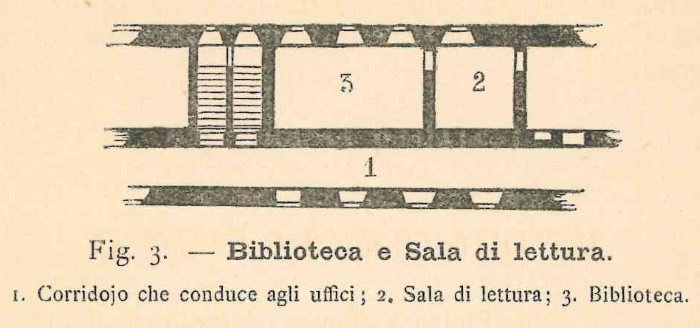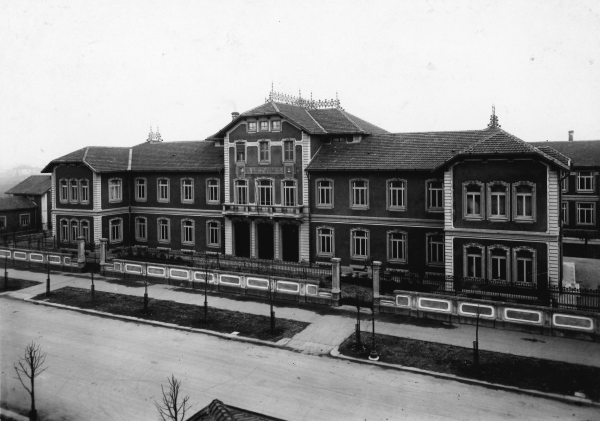About the Library
The Biblioteca di Medicina Veterinaria was established in 1808 as the Library of the Royal Higher School of Veterinary Medicine. It was founded following the closure of the Minor School of Veterinary Medicine at the Lazzaretto, giving rise to the School of Instruction for Veterinary Art and Rural Veterinary Economy in the former convent of Santa Francesca Romana.
The library underwent its first expansion in 1835, during the initial Austrian reform of the School led by Director Professor Laurin, and again in 1871 under the direction of Professor Oreste, who initiated the collection of French and German veterinary serials.
In 1879, the school came under the leadership of Professor Nicola Lanzillotti-Buonsanti, who modernised and expanded the library by acquiring some of the most important publications of the time, primarily focusing on veterinary medicine, human medicine, and agriculture. By 1891, the library held approximately five thousand volumes, received around fifty Italian and foreign serials, and owned numerous rare and antique books. During this period, Oreste Pupilli, then secretary of the School, was tasked with compiling an author-ordered catalogue of the library’s holdings, which was published in 1908 with the aim of meeting the needs of professors, students, and scholars in the field. This work facilitated the reorganisation of the collection, ensuring that several incomplete works were supplemented where possible. The library’s expansion was further supported by acquisitions from its regular budget and donations from notable figures, including Director Professor Nicola Lanzillotti-Buonsanti, Professor Enrico Sertoli, and Professor Carlo Müller.
While still housed in the premises of Santa Francesca Romana, the library underwent a relocation to accommodate the needs of the Institute of Physiology and the Medical Pathology Cabinet. It was moved from the old director’s quarters to the first floor, which had previously served as the director’s residence (see Picture 1). This relocation provided the library with two rooms dedicated to serials, a long corridor and an additional room for books, a reading room for professors—which was also used for Council meetings (see Picture 2)—and a smaller reading room for students.
At that time, the building also housed several institutes and laboratories, each specialising in different veterinary disciplines.
In 1927, following a project dating back to 1912 aimed at concentrating all higher education institutions in the district known as the Città degli Studi, the Royal Higher School of Veterinary Medicine, then under the direction of Pietro Stazzi, was relocated from Santa Francesca Romana to newly constructed buildings at Via Celoria 10. The central building housed the School’s Directorate, administrative and secretarial offices, and the main lecture hall (see Picture 3). Various institutes occupied the surrounding buildings, each hosting a small library tailored to its specific academic and research needs.
In the spring of 1933, the Royal School of Veterinary Medicine was incorporated as the Faculty of Veterinary Medicine into the Royal University of Milan, without substantial changes to its structure or operations. The library was renamed the Biblioteca Centrale della Facoltà di Medicina Veterinaria (Central Library of the Faculty of Veterinary Medicine).
Due to the wartime events, the following years are difficult to reconstruct as the minutes of the Faculty Council were lost. From scant notes in the annual reports and archival documents, we know that in 1935, Franco Landolfi was the sole librarian of the Central Library of the Faculty of Veterinary Medicine and the Library of the Faculty of Agriculture, assisted by an employee and a janitor. In the 1936/37 academic year, responsibility for the library passed to Giacomo Pallavicino, assisted by only one janitor. In March 1940, Roberto Cartigliani was appointed to reorganize the library, which had been closed in the preceding months. In the 1941/42 academic year, the library was entrusted to Miss Cesarina Barattini, assisted by a janitor, to whom a second janitor was later added. However, due to the wartime events, Miss Barattini soon found herself working alone again. In 1947, the library, which had by then separated from that of the Faculty of Agriculture, was formally merged with the Library of the Faculties of Law, Arts, and Philosophy, remaining so until 1963, when it became independent.
Between 1965 and 1970, Professor Luigi Leinati, having been reappointed to a non-teaching role, was entrusted by the Faculty with the position of Scientific Director, tasked with overseeing the operation of the library, which remained under the management of Miss Barattini.
From 1980 onwards, the library underwent a period of significant transformation, beginning with the expansion of its premises. Originally occupying two floors, it was extended to four, allowing for the development of collections and services, which saw a qualitative leap with the advent of computerisation. In the years that followed, various directors took turns at the helm, the staff was expanded, and the library took on the responsibility of managing the institute libraries, which later became departmental libraries.
On 25 September 2012, the Library Council unanimously approved the renaming of the library from “Biblioteca Centrale della Facoltà di Medicina Veterinaria” to “Biblioteca di Medicina Veterinaria”.
In September 2019, the library relocated from its historic site in Milan to its new premises in Lodi, where the Veterinary Hospital had already been in operation for several years and where most of the teaching activities were taking place. This move provided the ideal opportunity to consolidate all collections, including those of the departments, making them fully accessible to users.
At its new location, the library is situated at the heart of the teaching area, within the building designed by the renowned Japanese architect Kengo Kuma. Here, the interiors are open and filled with natural light (see Picture 4), with architecture and nature blending harmoniously thanks to the use of materials such as wood and glass, as well as the surrounding green landscapes of the Lodi countryside, the waters of the Bertonica Canal, and the nearby small lake.






